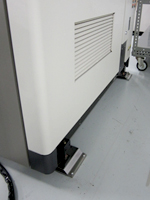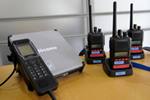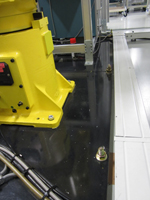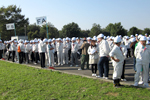 웹 내용 전시
웹 내용 전시

Risk management basic policy and structure
The Advantest Group will conduct measures to minimize damage should any of the following events occur:
- If damage is caused to buildings or facilities, or if networks and systems stop functioning making it difficult to continue our business operations, or if there is the possibility of this type of situation occurring due to a disaster or accident;
- If there is the danger of one of our executives or employees being killed or injured or their life or physical health is put at risk due to a disaster or accident;
- If there is an occurrence of scandal or incident that has the potential to become a social concern; or,
- If any event other than those described above were to occur that could cause a significant impact on the business of the Group or its affiliates due to a disaster or accident.
Organizational structure for promoting risk management
The Risk Management Group (Group Manager: President) was established in December 2001. If any of the events described above should occur, the Risk Management Group quickly convenes to unify information, conduct an initial evaluation, make adjustments between divisions, and establish recovery plans. This Group continues operations until recovery work is fully completed.
Business Continuity Plan
Advantest Corporation established the following basic policy during fiscal 2007 in preparation for large-scale natural disasters. We have devised our business continuity plan based on this policy.
Business continuity plan basic policy
- If a disaster occurs near any of our offices and factories, the safety of employees and their families must be secured first and foremost.
- Disaster prevention activities, as well as recovery activities in the event a disaster occurs near any of our offices and factories, must be conducted diligently and in collaboration with local communities.
- We must fulfill our responsibility to our stakeholders by ensuring that any damage caused to our business by a disaster has a minimal impact on suppliers and other stakeholders.

Tip-over prevention for
production facilities

Satellite phone and
transceivers

Stabilizing the floor for
production facilities

Disaster drills
The Great East Japan Earthquake that occurred in March 2011 was a catastrophe of such proportions that it has reaffirmed our awareness that unexpected events can and do occur. Advantest formulated a business continuity plan during fiscal 2007 in preparation for large-scale earthquakes. As a result of floor stabilizing and tip-over prevention work that was conducted on production facilities in line with this plan, it was possible to resume business with limited problems. However upon reflection of the lessons learned in the recent earthquake, we have become aware that there is the need to establish a more practical business continuity plan based on updated damage assumptions, and that we also need to improve and expand our training and drill system.
We focused on three initiatives during fiscal 2011, consisting of a review of our disaster prevention system following the Great East Japan Earthquake; energy saving measures in response to planned power outages and power shortages; and an update of disaster restoration manuals and a restructuring of our business continuity plan.
After conducting a review of our disaster prevention system, we adopted a system that has allowed for more rapid evacuation and safety confirmation in the event of disasters through the distribution of disaster safety helmets to all employees and other measures including changes in the self-defensive organization for disaster prevention and evacuation sites. Furthermore, satellite telephones and transceivers were installed at all business locations in preparation for interruptions in the telecommunications infrastructure.
In terms of response to planned power outages, we managed to continue with operations without any slowdown in production and development through the adoption of a shift working system as a form of provisional response. In energy saving measures in response to summer power shortages, private power generators were installed at the Gunma R&D Center, Gunma Factory, and Gunma Factory 2. In addition, the air conditioning temperature was set at 28°C as a general rule, and room temperatures were decreased by sprinkling water on roofs. As a result of these and other measures, we achieved a 35% reduction from peak power use last summer (initial target of 20 % reduction, government policy of 15% reduction).
In addition, disaster restoration manuals were updated for all managing departments. In the restructuring of our business continuity plan, we worked towards reconfirming the current situation and revealing the issues we face, and confirmed the importance of cooperating with and contributing to the local community through a partnership with a municipality organization in Meiwacho.
Following the earthquake, as a result of these measures, our employees have become more aware of disasters and we have conducted more practical disaster and evacuation drills. As we restructure our business continuity plan in the future, we plan to further expand the scope of our training and drills, and take steps towards establishing business continuity management to ensure that damage assumptions are updated, the contents of our plans are verified, and that the business continuity plan is adequately implemented and improved upon.
Response to the H1N1 flu
Advantest began gathering information on the H1N1 fl u as early as 2007, and was prepared for a possible pandemic from the outset. In April 2009, when the flu spread rapidly, we determined countermeasures to check infections, and implemented them in close cooperation with subsidiaries both in Japan and overseas. Employees were updated on the situation within the company and their communities, and reminded at every meeting that protection is better than cure. Infected employees or employees with infected household members were contacted individually to communicate procedures for returning to work as well as advice on what actions to take at home. These and other risk-reduction measures illustrate Advantest’s commitment to protecting the safety of employees and their families and ensuring the continuity of business operations.

